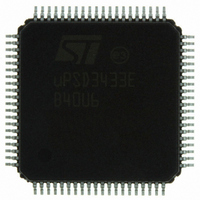UPSD3433EB40U6 STMicroelectronics, UPSD3433EB40U6 Datasheet - Page 116

UPSD3433EB40U6
Manufacturer Part Number
UPSD3433EB40U6
Description
MCU 8BIT 8032 128KB FLASH 80TQFP
Manufacturer
STMicroelectronics
Series
µPSDr
Datasheet
1.UPSD3434EB40T6.pdf
(293 pages)
Specifications of UPSD3433EB40U6
Core Processor
8032
Core Size
8-Bit
Speed
40MHz
Connectivity
I²C, IrDA, SPI, UART/USART, USB
Peripherals
LVD, POR, PWM, WDT
Number Of I /o
46
Program Memory Size
160KB (160K x 8)
Program Memory Type
FLASH
Ram Size
8K x 8
Voltage - Supply (vcc/vdd)
3 V ~ 5.5 V
Data Converters
A/D 8x10b
Oscillator Type
Internal
Operating Temperature
-40°C ~ 85°C
Package / Case
80-TQFP, 80-VQFP
For Use With
497-5518 - EVAL BOARD RFID READER497-5046 - KIT TOOL FOR ST7/UPSD/STR7 MCU
Lead Free Status / RoHS Status
Lead free / RoHS Compliant
Eeprom Size
-
Other names
497-5660
Available stocks
Company
Part Number
Manufacturer
Quantity
Price
Company:
Part Number:
UPSD3433EB40U6
Manufacturer:
STMicroelectronics
Quantity:
10 000
- Current page: 116 of 293
- Download datasheet (5Mb)
I
23.2
116/293
2
C interface
Communication flow
I
lines with open-drain (or open-collector) line drivers pulled up with external resistors,
creating a wired-AND situation. This means that either bus line (SDA or SCL) will be at a
logic '1' level only when no I
handshaking, arbitration, synchronization, and collision detection is implemented by each
I
1.
2.
Assert high means the driver releases the line and external pull-ups passively raise the
signal to logic '1.' Holding low means the open-drain driver is actively pulling the signal to
ground for a logic '0.'
For example, if a Slave device cannot transmit or receive a byte because it is distracted by
and interrupt or it has to wait for some process to complete, it can hold the SCL clock line
low. Even though the Master device is generating the SCL clock, the Master will sense that
the Slave is holding the SCL line low against the will of the Master, indicating that the Master
must wait until the Slave releases SCL before proceeding with the transfer.
Another example is when two Master devices try to put information on the bus
simultaneously, the first one to release the SDA data line looses arbitration while the winner
continues to hold SDA low.
Two types of data transfers are possible with I
on page
1.
2.
2
2
C data flow control is based on the fact that all I
C device having:
The ability to hold a line low against the will of the other devices who are trying to
assert the line high.
The ability of a device to detect that another device is driving the line low against its will.
Data transfer from Master Transmitter to Slave Receiver (R/W = 0). In this case, the
Master generates a START condition on the bus and it generates a clock signal on the
SCL line. Then the Master transmits the first byte on the SDA line containing the 7-bit
Slave address plus the R/W bit. The Slave who owns that address will respond with an
acknowledge bit on SDA, and all other Slave devices will not respond. Next, the Master
will transmit a data byte (or bytes) that the addressed Slave must receive. The Slave
will return an acknowledge bit after each data byte it successfully receives. After the
final byte is transmitted by the Master, the Master will generate a STOP condition on
the bus, or it will generate a RE-START conditon and begin the next transfer. There is
no limit to the number of bytes that can be transmitted during a transfer session.
Data transfer from Slave Transmitter to Master Receiver (R/W = 1). In this case, the
Master generates a START condition on the bus and it generates a clock signal on the
SCL line. Then the Master transmits the first byte on the SDA line containing the 7-bit
Slave address plus the R/W bit. The Slave who owns that address will respond with an
acknowledge bit on SDA, and all other Slave devices will not respond. Next, the
addressed Slave will transmit a data byte (or bytes) to the Master. The Master will
return an acknowledge bit after each data byte it successfully receives, unless it is the
last byte the Master desires. If so, the Master will not acknowledge the last byte and
from this, the Slave knows to stop transmitting data bytes to the Master. The Master will
then generate a STOP condition on the bus, or it will generate a RE-START conditon
and begin the next transfer. There is no limit to the number of bytes that can be
transmitted during a transfer session.
117.
2
C device is actively driving the line to logic '0.' The logic for
2
C depending on the R/W bit, see
2
C compatible devices will drive the bus
Figure 42
uPSD34xx
Related parts for UPSD3433EB40U6
Image
Part Number
Description
Manufacturer
Datasheet
Request
R

Part Number:
Description:
MCU 8BIT 8032 128KB FLASH 80TQFP
Manufacturer:
STMicroelectronics
Datasheet:

Part Number:
Description:
MCU 8BIT 8032 128KB FLASH 52TQFP
Manufacturer:
STMicroelectronics
Datasheet:

Part Number:
Description:
STMicroelectronics [RIPPLE-CARRY BINARY COUNTER/DIVIDERS]
Manufacturer:
STMicroelectronics
Datasheet:

Part Number:
Description:
STMicroelectronics [LIQUID-CRYSTAL DISPLAY DRIVERS]
Manufacturer:
STMicroelectronics
Datasheet:

Part Number:
Description:
BOARD EVAL FOR MEMS SENSORS
Manufacturer:
STMicroelectronics
Datasheet:

Part Number:
Description:
NPN TRANSISTOR POWER MODULE
Manufacturer:
STMicroelectronics
Datasheet:

Part Number:
Description:
TURBOSWITCH ULTRA-FAST HIGH VOLTAGE DIODE
Manufacturer:
STMicroelectronics
Datasheet:

Part Number:
Description:
Manufacturer:
STMicroelectronics
Datasheet:

Part Number:
Description:
DIODE / SCR MODULE
Manufacturer:
STMicroelectronics
Datasheet:

Part Number:
Description:
DIODE / SCR MODULE
Manufacturer:
STMicroelectronics
Datasheet:

Part Number:
Description:
Search -----> STE16N100
Manufacturer:
STMicroelectronics
Datasheet:

Part Number:
Description:
Search ---> STE53NA50
Manufacturer:
STMicroelectronics
Datasheet:











